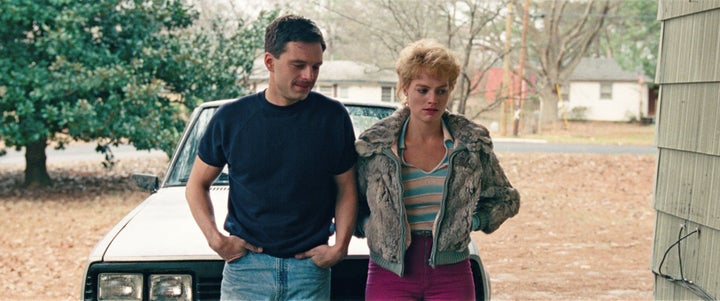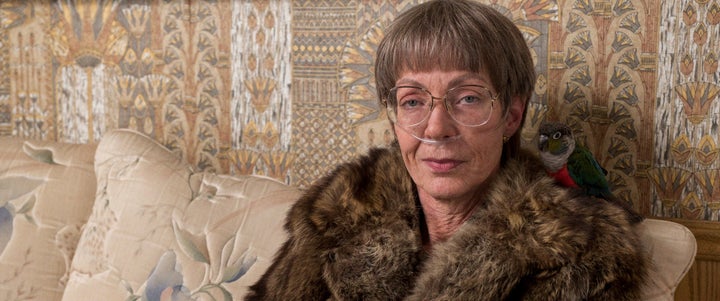“I, Tonya” begins with a disclosure. It is, according to text that appears onscreen, “based on irony-free, wildly contradictory, totally true interviews with Tonya Harding and Jeff Gillooly,” the former a disgraced Olympic figure skater and the latter her ex-husband.
The disclaimer itself is a contradiction. Most biopics, which purport to tell real stories about real people, follow a similar formula. Whether cradle-to-grave profiles or snapshots of one critical moment, they usually take a grand, sweeping view. The acting is mannered and transparent, the stories are familiar and firm in their conclusions, and many attempt to link historical moments with present-day analogs. “I, Tonya” certainly belongs to the biopic genre, but nothing about it is formulaic. Almost everything that happens in the movie is at once fact and fiction.
For those who devoured the Harding soap opera in the ’90s, rest assured its signature plotlines are the centerpiece of “I, Tonya.” Her rival, Nancy Kerrigan, is the wholesome all-American girl. Harding is the inelegant outsider whose success stems largely from her own grit. On her path to Olympic glory, she goes from scrappy redneck to improbable media princess. Anyone who loves an underdog roots for Tonya Harding.
The movie, which opened in limited release last weekend, leans into its heroine’s pursuit of the American dream. As implied in the opening confession, it also embraces the idea that we will never know just how much Harding knew about the scheme to injure Kerrigan backstage at the 1994 U.S. Figure Skating Championships, where Kerrigan was seen wailing “Why?” after a bodyguard hired by Gillooly struck her legs.

“Everyone has a different point of view or a different memory,” the movie’s screenwriter, Steven Rogers, told HuffPost soon after its Toronto International Film Festival premiere in September. “But that’s very human. I think people tell themselves what they need to tell themselves in order to live with themselves. They were all trying to control the narrative in their interviews. But that’s what we do, all of us.”
Said interviews form the movie’s framing device: a faux documentary that somewhat resembles the popular Harding-Kerrigan episode of ESPN’s “30 for 30.” Anytime a scene is presented as fact, a character ― Harding (Margot Robbie), Gillooly (Sebastian Stan), her abusive mother (Allison Janney), the aforementioned dweeb of a bodyguard (Paul Hauser) ― breaks the fourth wall to negate someone else’s account of the unfolding events. The structure deconstructs biopic tropes, which dramatize unknowable aspects of public figures’ lives under the guise of truth.
Gillooly, for example, swears he’s a “pretty meek guy” who never hit Harding, but the movie won’t accept that claim at face value. Immediately we see Gillooly abusing her in their living room. Then back to the documentary-style interview, in which he says she once tried to shoot him. Harding marches through their home, rifle in hand. “This is bullshit. I never did this,” she tells the camera as she cocks the gun, turns back to Gillooly and fires in his direction.
Rogers, whose credits include “Stepmom” and “Kate & Leopold,” said he knew what he was going for almost immediately with “I, Tonya.” After tracking down Harding to secure the rights to her story ― the number listed for her agent led to a Motel 6, which only intrigued Rogers further ― he conducted separate interviews with her and Gillooly, whom Harding had divorced in 1993 but reconciled with shortly thereafter.
“Their stories were wildly contradictory,” Rogers said. “They remember nothing the same. I thought that’s my in. I’ll see what Tonya says, what Jeff says, what Shawn the bodyguard says, and I’ll just let the audience decide [what to believe]. ... They’re all rebels, but they’re also kind of wrongheaded. I wanted the script to reflect that.”

Playing fast and loose with perceptions of truth also befits “I, Tonya” because it captures the early days of the 24-hour news cycle. 1994 is sometimes considered when reality television crystallized, both in its literal form (“The Real World” had premiered two years earlier) and its media-produced simulacrum (O.J. Simpson’s high-speed car chase occurred that June; his murder trial began the following January, captivating the nation). The melodrama of Kerrigan’s attack at the hands of Harding’s merry band of buffoons was central to that media frenzy that feasts on scandals and salacious victuals.
“Part of the reason it’s called ‘I, Tonya’ is it’s partly a riff on ‘I, Claudius’ by Robert Graves, but it’s also ‘I, Tonya, swear to tell the truth, the whole truth, and nothing but the truth,’” Rogers said. “Our movie has so much to do with that. I also didn’t want it to be just one thing because the characters in real life were reduced to a punchline, to just one thing. I wanted everything to be more than one thing. I wanted the tone to be more than one thing. I wanted the characters to be more than one thing.”
Hence the movie, directed by “Lars and the Real Girl” and “Their Finest Hours” maestro Craig Gillespie, adopts the tone of a Coen brothers joint. It’s a comedy pitched to the blackest degree, especially with Janney’s foul-mouthed, chain-smoking, parrot-toting, knife-throwing LaVona Golden on hand. Harding’s now-estranged mother’s abusive tendencies made her something of a villain throughout the ordeal. Her violent outbursts ― pushing a young Tonya off a high chair, for example ― and chilly temper are played for laughs that stay just shy of exploitative, as “I, Tonya” keeps its audience squarely in its title subject’s corner. For Harding, abuse was an everyday part of life, as navigable as breakfast or skating practice.
The way “I, Tonya” twists assertions of truth is reminiscent of “Jackie,” another unconventional biopic, in which Jackie Kennedy (Natalie Portman) carefully sculpts the Camelot narrative that she presents to the world in the wake of her husband’s assassination. Here, everyone with stock in Harding’s downfall spins yarns that benefit their individual images. In the end, there are few firm conclusions.
“These were human beings,” Rogers said. “What I wanted to do was to humanize them and say there’s more to a story than just the comments section. Everybody has an opinion, and they don’t even know the person. They just know what’s been said. It’s an epidemic, and this was sort of the start of that. ... Before you judge so harshly, there’s a bigger story that’s not being told, and it’s not black and white — it’s gray. And gray is what’s interesting because it’s messy.”

